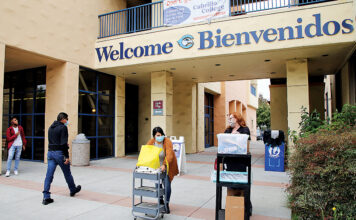SANTA CRUZ COUNTY—The 2022 State of Oral Health Needs Assessment has revealed the continued massive gap in dental care for low-income residents in Santa Cruz County.
The findings are part of a 2022 study conducted by dental healthcare research firm Barbara Aved Associates. They found that where 82,000 people had Medi-Cal, only 38% could go to the dentist.
There were some gains over the first study in 2016. For instance, 8,000 more people have Medi-Cal and 6,000 more people were able to go to the dentist. But 51,000 people were not able to make an annual dental visit.
The report found that the highest proportion (68%) of people on Medi-Cal who go to the dentist are between the ages 6 to 9. This rate dramatically drops off in the pre-teenage and teenage years to a low of 21% by age 21. The rate of dentist visits stays low throughout adulthood, increasing slightly after age 30–a trend that is mirrored by the state of California.
Santa Cruz County is faring better than the State for children ages 0-2, with 57% of Santa Cruz County babies and toddlers with Medi-Cal insurance having annual dental visits, versus 25% for the State. Santa Cruz County has seen a 60% jump in utilization for this age group since 2016.
There has also been a reduction in tooth decay amongst kindergarteners to 18% from a high of 24% in 2016. Dientes Community Dental Care representatives say these gains are due to a focused awareness campaign about going to the dentist by a child’s first tooth or first birthday conducted by Oral Health Access Santa Cruz County and its members.
The study also revealed that the largest increase in access to care was for adults, with 5,000 more adults with Medi-Cal making annual dental visits. Yet, the proportion of adults who go to the dentist is still very low, with 75% of adults with Medi-Cal unable to receive care.
Seniors have high rates of gum disease (65%) and missing teeth but receive no dental benefits through Medicare.
Hispanic populations have the highest utilization of dental benefits for low-income residents with Medi-Cal at 48%, followed by Asians (33%), Other (30%), Native Hawaiians and Pacific Islanders (23%), Blacks (22%) and Alaskan Natives and Native Americans (21%).
“This study is critical to align resources behind the greatest needs in our community,” Dientes EVP of Operations and co-Chair of Oral Health Access Santa Cruz County Dr. Sepi Taghvaei said in a press release. “We have made a concerted effort on oral health education, promoting the application of fluoride varnish in well-child medical visits, and making sure kindergarteners have a dental home for our youngest patients and are proud of the results. We have also expanded access to care for patients of all ages. Building on that success, we are looking at how to move the needle for other important groups.”
For information and to view a summary of the full study, visit oralhealthscc.org/findings.











